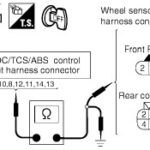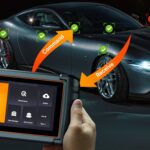In today’s technologically advanced automotive landscape, understanding your car’s health is no longer a task solely for mechanics. With the advent of Bluetooth Obd2 Diagnostic Tools, car owners now have unprecedented access to real-time vehicle data, right at their fingertips. These innovative tools are transforming how we interact with our cars, empowering us to diagnose issues, monitor performance, and stay ahead of potential problems, all from the convenience of our smartphones.
What is a Bluetooth OBD2 Diagnostic Tool?
A Bluetooth OBD2 diagnostic tool is a compact device that plugs into your car’s OBD2 port – typically located under the dashboard. This port, standardized in most vehicles manufactured after 1996, provides access to your car’s Engine Control Unit (ECU), the brain of your vehicle’s engine management system. The “Bluetooth” aspect is key; it allows the tool to wirelessly transmit the data it retrieves to your smartphone, tablet, or other Bluetooth-enabled devices.
This eliminates the need for cumbersome wires and allows for a user-friendly, mobile diagnostic experience. Paired with a compatible app on your device, a Bluetooth OBD2 tool becomes a powerful window into your car’s inner workings.
Key Features to Look for in a Bluetooth OBD2 Diagnostic Tool
When considering a Bluetooth OBD2 diagnostic tool, several features are crucial for effective vehicle monitoring and diagnostics:
- Fault Code Reading and Resetting: At its core, a good OBD2 tool should accurately read Diagnostic Trouble Codes (DTCs), commonly known as fault codes. These codes are generated by your car’s computer when it detects a problem. Crucially, the tool should also allow you to reset these codes, especially helpful after you’ve addressed the underlying issue.
- Live Data Streaming: Real-time sensor data is invaluable for understanding your car’s performance. Look for a tool that can stream live data from various sensors, including engine temperature, RPM, speed, oxygen sensor readings, and more. This live data helps you monitor engine health and identify anomalies as they occur.
- Extensive Vehicle Compatibility: Ensure the tool is compatible with your vehicle’s make and model. While OBD2 is a standard, some tools offer enhanced compatibility with specific brands, providing access to manufacturer-specific data and features.
- User-Friendly App Interface: The accompanying mobile app is just as important as the OBD2 adapter itself. A well-designed app should be intuitive, easy to navigate, and present data in a clear, understandable format. Customizable dashboards and gauge layouts are a plus, allowing you to focus on the data most relevant to you.
- Advanced Diagnostic Features: Some advanced tools offer features beyond basic code reading and live data. These can include:
- Freeze Frame Data: Captures sensor readings at the moment a fault code is triggered, providing valuable context for diagnosis.
- Mode 06 Testing: Access to ECU self-monitoring test results, helpful for identifying intermittent issues.
- Emission Readiness Tests: Confirms if your car is ready for emissions testing, saving you time and potential failures.
- Performance Measurement: Features for measuring acceleration, horsepower, and other performance metrics.
- Trip Computer Functionality: Tracks fuel consumption, trip distance, and other driving statistics.
Benefits of Using a Bluetooth OBD2 Diagnostic Tool
Investing in a Bluetooth OBD2 diagnostic tool offers numerous advantages for car owners:
- Save Money on Repairs: By diagnosing minor issues early, you can often prevent them from escalating into costly repairs at a mechanic. Understanding fault codes empowers you to have informed conversations with mechanics, potentially avoiding unnecessary services.
- Proactive Vehicle Maintenance: Monitoring live data allows you to spot potential problems before they trigger warning lights or cause breakdowns. This proactive approach to maintenance can extend your car’s lifespan and improve its reliability.
- Understand Your Car Better: OBD2 tools demystify your car’s complex systems, giving you a deeper understanding of how it operates. This knowledge can increase your confidence in car ownership and maintenance.
- DIY Car Repairs: For those inclined to DIY car maintenance, a Bluetooth OBD2 tool is an indispensable asset. It provides the diagnostic information needed to tackle repairs yourself, saving on labor costs.
- Emission Test Readiness: Ensure your vehicle will pass emissions tests before going to the testing center, avoiding re-test fees and inconvenience.
Car Scanner App: A Powerful Companion for Your Bluetooth OBD2 Tool
The Car Scanner ELM OBD2 app is an excellent example of software designed to maximize the potential of Bluetooth OBD2 diagnostic tools. It offers a wide array of features, many of which are available for free, making it a compelling choice for both novice and experienced users.
Key features of the Car Scanner app, aligning with the benefits of Bluetooth OBD2 tools, include:
- Customizable Dashboards: Create personalized dashboards displaying the gauges and charts that are most important to you, focusing on the data you need to see at a glance.
- Extended PID Support: Access hidden data beyond standard OBD2 parameters, retrieving information often concealed by car manufacturers for deeper insights into vehicle performance.
- Comprehensive Fault Code Database: The app includes a vast database of DTC code descriptions, helping you understand the meaning of fault codes and potential causes.
- Advanced Features: Car Scanner incorporates advanced capabilities like Mode 06 testing, freeze frame data, emission readiness checks, and performance measurements, providing a comprehensive diagnostic suite.
- Vehicle-Specific Profiles: Offers specialized connection profiles for various car brands like Toyota, Mitsubishi, GM, and BMW, unlocking extra features and enhanced compatibility.
- HUD Mode: Project data onto your windshield using the Heads-Up Display (HUD) mode, allowing for safer and more convenient real-time monitoring while driving.
- Trip Computer and Fuel Economy Tracking: Functions as a trip computer, providing fuel consumption statistics and trip data for efficient driving analysis.
- VAG Group Encoding: For Volkswagen, Audi, Skoda, and Seat vehicles on MQB and PQ26 platforms, the app enables encoding functions to customize hidden car parameters.
Choosing the Right Bluetooth OBD2 Adapter
While the app is crucial, the Bluetooth OBD2 adapter itself plays a vital role in the tool’s performance. When selecting an adapter, consider these points:
- Compatibility: Ensure the adapter is compatible with your vehicle’s OBD2 protocol and the Car Scanner app or your chosen diagnostic software.
- Bluetooth Version: Bluetooth 4.0 (Bluetooth LE) is recommended for faster and more reliable data transmission with lower energy consumption.
- Adapter Quality: Opt for reputable brands like Kiwi 3, Viecar, V-Gate, Carista, LELink, or Veepeak for reliable performance and to avoid connection issues or potential damage to your car’s ECU.
- Avoid Cheap Clones: Be wary of very cheap, unbranded ELM327 adapters, particularly those marked “v.2.1.” These clones can be unreliable, suffer from bugs, and may even cause connection problems or unstable engine operation. Genuine ELM327 chips are preferable for optimal performance.
Conclusion
Bluetooth OBD2 diagnostic tools have democratized car diagnostics, placing powerful vehicle insights within reach of everyday car owners. Combined with user-friendly apps like Car Scanner, these tools empower you to understand your car’s health, perform proactive maintenance, and potentially save significant money on repairs. By choosing the right Bluetooth OBD2 adapter and leveraging the capabilities of a comprehensive app, you can unlock your car’s secrets and drive with greater confidence and peace of mind.

